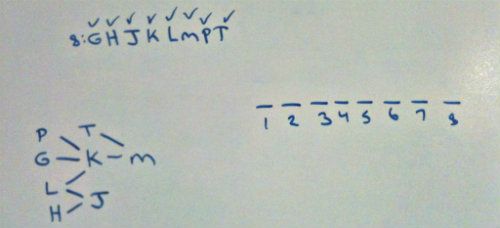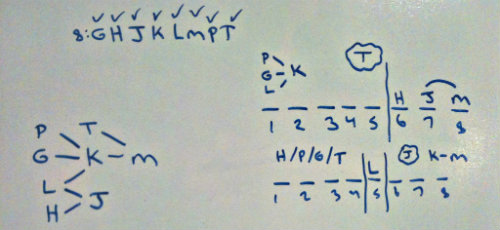Hello could you elaborate on question 10 11 and 12 please
each time I do it i get a different answer/my methods of coming up with the answers are too time consuming?
thanks!
-tawana
LSAT Forum
4 postsPage 1 of 1
-

- timmydoeslsat
-
Thanks Received: 887
-
Atticus Finch

- Posts: 1136
- Joined: June 20th, 2011

- Most Thanked

- First Responder
Re: Q10
My global diagram:

Something to consider before you even look at the questions is that only two different variables could be last: M or J. So if you have a situation where they tell you that M is 6th for instance, then you know that J must be last.
Question 10 is a local question asking what must be true if J is third. We just talked about this sort of thing. If J isn't last, then M is. Answer choice E.
Question 11 is another local question asking what must be true if H is sixth. After plugging that in, we know that J must follow in either 7th or 8th. What could be the other variable that occupies the other of those two slots? It must be M. Every other variable left must precede M. So we now have M and J trading off in slots 7 and 8. T is now a floater, as no matter where you place it in slots 1-5, it will be before M, which is the only rule governing T.

(The first hypothetical is information regarding Question 11. The one below is information regarding Question 12.)
The other variables that are left are PGLK, and we know that there is an order to be maintained among these variables. PGL must precede K.
So what must be true? (D) K before J.
Question 12 is a local question asking what could be true if L is fifth. There are three slots open after L, and we know of exactly three variables that must proceed L: J, and a K-M sequence of some form. That will occupy slots 6-8. Slots 1-4 will be occupied by the now-floaters HPGT. The rules governing these four remaining variables were simply rules telling each of them to precede the variables found in slots 5-8. So the placement of the variables remaining in slots 1-4 is truly interchangeable.

(The first hypothetical is information regarding Question 11. The one below is information regarding Question 12.)
So what could be true? (E) M before J.

Something to consider before you even look at the questions is that only two different variables could be last: M or J. So if you have a situation where they tell you that M is 6th for instance, then you know that J must be last.
Question 10 is a local question asking what must be true if J is third. We just talked about this sort of thing. If J isn't last, then M is. Answer choice E.
Question 11 is another local question asking what must be true if H is sixth. After plugging that in, we know that J must follow in either 7th or 8th. What could be the other variable that occupies the other of those two slots? It must be M. Every other variable left must precede M. So we now have M and J trading off in slots 7 and 8. T is now a floater, as no matter where you place it in slots 1-5, it will be before M, which is the only rule governing T.

(The first hypothetical is information regarding Question 11. The one below is information regarding Question 12.)
The other variables that are left are PGLK, and we know that there is an order to be maintained among these variables. PGL must precede K.
So what must be true? (D) K before J.
Question 12 is a local question asking what could be true if L is fifth. There are three slots open after L, and we know of exactly three variables that must proceed L: J, and a K-M sequence of some form. That will occupy slots 6-8. Slots 1-4 will be occupied by the now-floaters HPGT. The rules governing these four remaining variables were simply rules telling each of them to precede the variables found in slots 5-8. So the placement of the variables remaining in slots 1-4 is truly interchangeable.

(The first hypothetical is information regarding Question 11. The one below is information regarding Question 12.)
So what could be true? (E) M before J.
-

- tommywallach
-
Thanks Received: 468
-
Atticus Finch

- Posts: 1041
- Joined: August 11th, 2009
Re: Q10
Hey Dc,
Framing is always optional. Some people find it faster/better to do more work up front (i.e. framing) while some people find it faster to do more work on the questions (i.e. not framing). That being said, if you're never framing, that's probably not great. You should be choosing to frame or not frame based on the individual game, not as a universal rule.
Good luck!
-t
Framing is always optional. Some people find it faster/better to do more work up front (i.e. framing) while some people find it faster to do more work on the questions (i.e. not framing). That being said, if you're never framing, that's probably not great. You should be choosing to frame or not frame based on the individual game, not as a universal rule.
Good luck!
-t
4 posts Page 1 of 1

